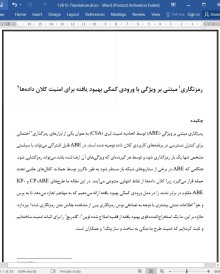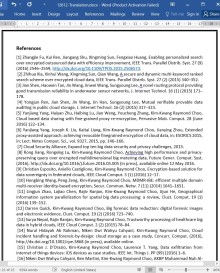
دانلود مقاله رمزنگاری مبتنی بر ویژگی با ورودی کمکی بهیود یافته برای امنیت کلان داده ها
چکیده
رمزنگاری مبتنی بر ویژگی (ABE) توسط اتحادیه امنیت ابری (CSA) به عنوان یکی از ابزارهای رمزگذاری احتمالی برای کنترل دسترسی در برنامههای کاربردی کلان داده توصیه شده است. در ABE فایل اشتراکی میتواند با سیاستی مشخص تنها یک بار رمزگذاری شود و توسط هر گیرندهای که ویژگیهای آن ارضا شده باشد میتواند رمزگشایی شود. هنگامی که ABE در برخی از سناریوهای شبکه باز مستقر شود به طور ناگریز توسط حملات کانالهای جانبی تحت حمله قرار میگیرد زیرا کلان دادهها از نقاط انتهایی متنوعی میآیند. در این مقاله ما طرحهای CP-ABE و KP-ABE مقاوم در برابر نشت را در مدل ورودی کمکی بهبود یافته ارائه میدهیم که به مهاجم اجازه میدهد تا به پرس و جو اطلاعات نشتی بیشتری با توجه به تصادفی بودن رمزنگاری پس از مشاهده چالش متن رمزنگاری شده بپردازد. علاوه بر این، ما یک استخراجکننده قوی بهبود یافته از قضیه اصلاح شده لوین - گلدریچ را برای اثبات امنیت ساختهایم و ثابت کردهایم که امنیت طرح ما متکی به ساخت و ساز ونگ و همکاران است.
1. مقدمه
محرمانگی، یکپارچگی و کنترل دسترسی مهمترین مسائل برای امنیت و حریم خصوصی شبکههای باز مانند شبکههای حسگر بی سیم، محاسبات ابری و محاسبات مه یا لبه هستند [1-6]. برای کنترل دسترسی، دو رویکرد اساسی متفاوت برای کنترل قابلیت دید دادهها برای نهادهای مختلف وجود دارد. اولین مورد کنترل دسترسی به دادهها با محدودسازی دسترسی به سیستم عاملهای اساسی است در حالیکه مورد دوم رمزگذاری دادهها با استفاده از رمزنگاری است. در قیاس این دو رویکرد به این نتیجه میرسیم که رویکرد دوم سطح حمله کوچکتر و دقیقتری را نشان میدهد. برای دسترسی به اطلاعات حساس به صورت امن، بسیاری از کاربران نهایی در برنامههای کاربردی کلاندادهها از گواهینامه x.509 برای شناسایی و ایجاد جلسات رمزنگاری استفاده میکنند. با این حال این گواهینامه زمان و پردازش زیادی برای به روزرسانی کلیدهای رمزنگاری را به طور مرتب نیاز دارد. بنابراین اتحادیه امنیت ابری (CSA) رمزنگاری مبتنی بر هویت (IBE) یا رمزنگاری مبتنی بر ویژگی (ABE) [8-10] را برای کنترل دسترسی در امنیت کلان دادهها پیشنهاد میدهد [7]. در قیاس با IBE، ABE ممکن است انتخاب بهتری برای کنترل دسترسی باشد زیرا نیاز به هیچگونه دانش پیشینی در مورد تعداد گیرندگان، هویت آنها یا گواهینامهها ندارد و به صاحب داده اجازه میدهد تا سیاست دسترسی خود را در مورد دادهها تعریف کند یعنی صاحب داده قادر به تعریف سیاستهایی است که بر اساس آنها تنها گیرندههایی مجاز شوند که ویژگیهای آنها برآوردهکننده سیاست است و میتوانند متن رمزنگاری شده را رمزگشایی کنند. ساهای و همکاران [22] مفهوم رمزنگاری مبتنی بر ویژگی (ABE) را در سال 2005 پیشنهاد دادند. دو نوع سیستم ABE وجود دارد: نخست سیاست متن رمزنگاری شده ABE (CP-ABE) است که در آنها متنهای رمزنگاری شده با سیاستهای دسترسی رمزگذاری شدهاند و کلیدها از ویژگیها استخراج میشوند و نوع دوم سیاست کلید ABE (KP-ABE) است که در آن کلیدها و متنهای رمزنگاری شده فقط معکوس میشوند.
6. نتیجهگیری
کنترل دسترسی یک چالش مهم امنیتی و حفظ حریم خصوصی در امنیت کلان دادهها است و ABE یک ابزار رمزنگاری مناسب برای کنترل دسترسی در بسیاری از شبکههای باز مانند مدیریت حوادث ابر، شبکههای حسگر بیسیم و سایر موارد است. با این حال، هنگامی که ABE در برنامههای کلان دادهها قرار میگیرد، تهدیدهای عملی برای هر دو مالک داده و کاربر وجود دارد. به عنوان مثال، کلید رمز دادههای کاربر (رمزگشا) ممکن است توسط حملات کانال کناری نشت پیدا کند در حالیکه تصادفی کردن مورد استفاده توسط صاحب داده (رمزگذار) نیز ممکن است به علت ضعف PRNG فاش شود. با این حال، طرحهای ABE مقاوم در برابر نشت موجود تنها نشت حاصل از رمزگشا را جذب میکنند و بنابراین طراحی یک طرح ABE مقاوم در برابر نشت برای ضبط نشت از هر دو سو همچنان به عنوان یک مشکل حل نشده باقی مانده است. در این مقاله، ما با ارائه یک مدل امنیتی از ABE مقاوم در برابر نشت با ورودی کمکی بهبود یافته سعی در حل آن مشکل داشتیم تا به مهاجم اجازه دهیم پس از دیدن متن رمزنگاری شده چالش برانگیز، کوئریهای نشتی بیشتری را انجام دهد. سپس، ما طرح CP-ABE بتنی و طرح KP-ABE را با ورودی کمکی بهبود یافته را بر اساس ساخت و ساز کار ونگ و همکاران ارائه دادیم. از تجزیه و تحلیل نظری و نتیجه تجربی، طرحهای ما راه حلهایی امن برای حجم و سرعت کلان دادهها است. علاوه بر این ما یک استخراجکننده قوی بهبود یافته از قضیه اصلاح شده گلدریچ لوین را برای اثبات امنیت ارائه دادیم و سپس ثابت کردیم که طرحهای ما از نظر CPA تحت ساز و کار امنیتی ونگ و همکاران امن است. از آنجا که رمزگذاری معمولا توسط دستگاههایی با منابع محدود در برنامههای کاربردی کلان دادهها انجام میشود، بهبود بهرهوری الگوریتم رمزگذاری در طرحهای ما یک مسیر تحقیقاتی جالب برای تحقیقات آتی خواهد بود.
Abstract
Attribute-based encryption (ABE) is recommended by the Cloud Security Alliance (CSA) as one of the possible cryptographic tools for access control in big data applications. In ABE, the shared file can be encrypted with the specific policy only once, and it can be decrypted by any receiver whose attributes are satisfied. When ABE is deployed in some open network scenarios, it is inevitably attacked by side channel attacks, because the big data are coming from diverse end-points. In this paper, we propose leakage resilient CP-ABE and KP-ABE schemes in the improved auxiliary input model, which allows the attacker query more leakage information regarding the encryption randomness after seeing the challenge ciphertext. Moreover, we construct an improved strong extractor from the modified Goldreich–Levin theorem for the security proof and prove that our scheme security relies on the Wang et al. construction.
1. Introduction
Confidentiality, integrity, and access control are the most important issues for the security and privacy of open networks, such as wireless sensor networks, cloud computing, and fog/edge computing [1–6]. For access control, there are two fundamentally different approaches for controlling data visibility to different entities. The first one is controlling data visibility by limiting access to the underlying operating systems, while the second one is encrypting the data using cryptography. Compared with the first approach, the second exposes a smaller, more well-defined attack surface. In order to access the sensitive information securely, many end users in big data applications utilize X.509 certificates for identification and cryptographic session establishment. However, it requires too much time and processing to periodically update cryptographic keys. Thus, the Cloud Security Alliance (CSA) recommended identity-based encryption (IBE) or attribute-based encryption (ABE) [8–10] for access control in big data security [7]. Compared with IBE, ABE may be a better choice for access control, because it does not need prior knowledge of the number of recipients, their identities, or certificates. It allows the data owner to define their own access policy on the data, such that only authorized receivers, whose attributes satisfy the policy, can decrypt the ciphertexts. Sahai et al. [22] proposed the concept of attribute-based encryption (ABE) in 2005. There are two kinds of ABE systems: The first is ciphertext-policy ABE (CP-ABE), where ciphertexts are encrypted with access policies, and keys are extracted from attributes; second is key-policy ABE (KP-ABE), where keys and ciphertexts are just the reverse.
6. Conclusion
Access control is a significant security and privacy challenge in big data security, and ABE is a good cryptographic tool for access control in many scenarios of open networks, such as cloud incident handling, wireless sensor networks, etc. However, when ABE is deployed in big data applications, there are practical threats for both data owner and user. For example, the data user’s (decryptor) secret key may be leaked by the side channel attacks, while the randomness used by the data owner (encryptor) can also be leaked owing to a PRNG weakness. However, existing leakage resilient ABE schemes only capture the leakage from the decryptor, and thus, designing a leakage resilient ABE scheme to capture the leakage from both sides remains an open problem. In this paper, we tackle this problem by proposing a security model of leakage resilient ABE with improved auxiliary input, which allows the attacker to make more leakage queries after seeing the challenge ciphertext. Then, we propose a concrete CP-ABE scheme and KP-ABE scheme with improved auxiliary input based on the Wang et al. construction. From the theoretical analysis and experimental result, our schemes are good secure solutions for the volume and velocity of big data. Furthermore, we propose an improved strong extractor from the modified Goldreich–Levin theorem for the security proof, and we prove that our schemes are CPA secure under the security of the Wang et al. construction. Because the encryption is usually executed by devices with constrained resources in big data applications, improving the efficiency of the encryption algorithm in our schemes is an interesting research direction in the future.
چکیده
1. مقدمه
2. پیشینه
1. 2 استخراجکننده قوی از قضیه اصلاح شده لوین- گلدریچ
2. 2 ساختار دسترسی
3. ABE با ورودی کمکی بهبودیافته
1. 3 تعریف
2 .3 مدل امنیتی
4. ساخت و ساز CP-ABE با ورودی کمکی بهبود یافته
1. 4 ساخت و ساز ما
2 .4 مقایسه عملکرد
5. ساخت KP-ABE با ورودی کمکی بهبود یافته
6. نتیجهگیری
منابع
ABSTRACT
1. Introduction
2. Background
2.1. Strong extractor from modified Goldreich–Levin theorem
2.2. Access structure
3. ABE with improved auxiliary input
3.1. Definition
3.2. Security model
4. Construction of CP-ABE with improved auxiliary input
4.1. Our construction
4.2. Performance comparison
5. Construction of KP-ABE with improved auxiliary input
6. Conclusion
References
- ترجمه فارسی مقاله با فرمت ورد (word) با قابلیت ویرایش، بدون آرم سایت ای ترجمه
- ترجمه فارسی مقاله با فرمت pdf، بدون آرم سایت ای ترجمه



